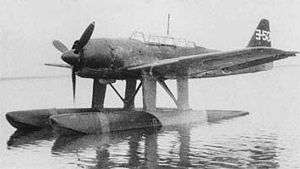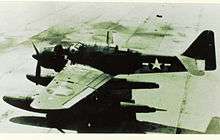Aichi E16A
The Aichi E16A Zuiun (瑞雲 "Auspicious Cloud", Allied reporting name "Paul") was a two-seat reconnaissance seaplane operated by the Imperial Japanese Navy during World War II.
| E16A Zuiun | |
|---|---|
 | |
| A E16A1 Yo-53 of the Yokosuka Kōkutai (Naval Air Group), as can be seen by its tail markings. | |
| Role | Reconnaissance Floatplane |
| Manufacturer | Aichi Kokuki |
| First flight | 22 May 1942 |
| Introduction | February 1944 |
| Primary user | IJN Air Service |
| Produced | 1944–1945 |
| Number built | 256[1] |
Design and development
The Aichi E16A originated from a 1939 specification for a replacement for the Aichi E13A, which at that time had yet to be accepted by the Imperial Japanese Navy Air Service (IJNAS).[2] Disagreements about the requirements in the 14-Shi specification prevented most manufacturers from submitting designs, but in 1941 a new 16-Shi specification was drafted by the IJNAS around the Aichi AM-22 design which had already been made by Aichi engineers Kishiro Matsuo and Yasuhiro Ozawa.[2] The first AM-22, which first got the experimental designation Navy Experimental 16-Shi Reconnaissance Seaplane and later the short designation E16A1, was completed by May 1942 and was a conventional, low-wing monoplane equipped with two floats and had the unusual (for a seaplane) feature of being equipped with dive brakes, located in the front legs of the float struts, to allow it to operate in a secondary role as a dive bomber.
Variants
- E16A1 Experimental Type 16 reconnaissance seaplane (16試水上偵察機, 16-Shi Suijō Teisatsuki)
- Initial named Experimental Type 14 two-seat reconnaissance seaplane (14試2座水上偵察機, 14-Shi 2-Za Suijō Teisatsuki). 3 prototypes produced. Mounted 1,300 hp (970 kW) Mitsubishi MK8A Kinsei 51 engine, 2 × forward-firing 7.7 mm (.303in) Type 97 machine guns, 1 × rearward-firing 7.7 mm Type 92 machine gun.
- E16A1 Zuiun Model 11 (瑞雲11型, Zuiun 11-gata)
- General production model. Mounted 1,300 hp (970 kW) Mitsubishi MK8N Kinsei 54 engine, 2 × forward-firing 20 mm Type 99-2 cannons, 1 × rearward-firing 13 mm Type 2 machine gun.
- E16A2 Provisional name Zuiun Model 12 (仮称瑞雲12型, Kashō Zuiun 12-gata)
- Initial named Zuiun Model 22. Single prototype with a 1,560 hp (1,160 kW) Mitsubishi MK8P Kinsei 62 radial engine. One plane converted from E16A1, incomplete.
Operators
- Imperial Japanese Navy Air Service
- Naval vessel
- Battleship Ise, supplied from 634th Kōkūtai.
- Battleship Hyūga, supplied from 634th Kōkūtai.
- Air unit
- Kitaura Kōkutai
- Yokosuka Kōkutai
- 634th Kōkutai
- 801st Kōkutai
- 301st Reconnaissance Hikōtai
- 302nd Reconnaissance Hikōtai
Specifications (E16A1 Zuiun Model 11)

Data from Japanese Aircraft of the Pacific War[1]
General characteristics
- Crew: 2
- Length: 10.833 m (35 ft 6 in)
- Wingspan: 12.81 m (42 ft 0 in)
- Height: 4.791 m (15 ft 9 in)
- Wing area: 28 m2 (300 sq ft)
- Empty weight: 2,945 kg (6,493 lb)
- Gross weight: 3,900 kg (8,598 lb)
- Max takeoff weight: 4,553 kg (10,038 lb)
- Powerplant: 1 × Mitsubishi MK8D Kinsei 54 14-cylinder air-cooled radial piston engine, 970 kW (1,300 hp) for take-off
- 895 kW (1,200 hp) at 3,000 m (9,843 ft)
- 820 kW (1,100 hp) at 6,200 m (20,341 ft)
- Propellers: 3-bladed constant-speed propeller
Performance
- Maximum speed: 439 km/h (273 mph, 237 kn) at 5,500 m (18,045 ft)
- Cruise speed: 333 km/h (207 mph, 180 kn) at 5,000 m (16,404 ft)
- Range: 1,176 km (731 mi, 635 nmi)
- Ferry range: 2,420 km (1,500 mi, 1,310 nmi)
- Service ceiling: 10,000 m (33,000 ft)
- Rate of climb: 10 m/s (2,000 ft/min)
- Time to altitude: 3,000 m (9,843 ft) in 4 minutes 40 seconds
- Wing loading: 139.3 kg/m2 (28.5 lb/sq ft)
- Power/mass: 0.2491 kW/kg (0.1515 hp/lb)
Armament
- Guns:
- 2 fixed forward-firing 20 mm (0.787 in) Type 99 Mark 2 machine guns in the wings
- 1 flexible rearward-firing 13 mm (0.512 in) Type 2 machine gun for the observer
- Bombs:
- 250 kg (551 lb) of bombs
See also
Aircraft of comparable role, configuration and era
Related lists
- List of aircraft of Japan during World War II
- List of aircraft of the Japanese Navy
- List of aircraft of World War II
- List of military aircraft of Japan
- List of seaplanes and amphibious aircraft
References
- Notes
- Francillon 1979, p. 287.
- Francillon 1979, p. 284.
- Bunrindō (1983), p. 110–111, p. 159–163
- Bunrindō (1994), p. 8, p. 25, p. 71–77
- Bibliography
- Francillon, Ph.D., René J. Japanese Aircraft of the Pacific War. London: Putnam & Company Ltd., 1979. ISBN 0-370-30251-6.
- Green, William. "Aichi E16A1 Zui-un (Paul)" War Planes of the Second World War, Volume Six: Floatplanes. London: Macdonald & Co.(Publishers) Ltd., 1962, pp. 116–118.
- Taylor, Michael J.H. Jane's Encyclopedia of Aviation. London: Studio Editions, 1989, p. 43.
- Bunrindō (Japan)
- Kōku-Fan Illustrated Special, Japanese Military Aircraft Illustrated Vol. 3 "Recinnaissance/Flying-boat/Trainer/Transport", January 1983
- Famous Airplanes of the World No. 47 "Imperial Japanese Navy Reconnaissance Seaplane", July 1994
External links
| Wikimedia Commons has media related to Aichi E16A. |